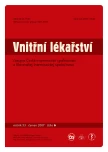Is familial hypercholesterolemia under control in the Czech Republic?
Authors:
T. Freiberger 1; R. Češka 2
Authors‘ workplace:
Genetická laboratoř Centra kardiovaskulární a transplantační chirurgie Brno, ředitel prof. MUDr. Jan Černý, CSc.
1; III. interní klinika 1. lékařské fakulty UK a VFN Praha, přednosta prof. MUDr. Štěpán Svačina, DrSc., MBA
2
Published in:
Vnitř Lék 2007; 53(6): 703-708
Category:
Reviews
Overview
In 1997, the Czech Republic joined the international project MedPed (Make early diagnosis to Prevent early deaths), the principal objective of which is to dramatically reduce the number of deaths caused by the premature clinical manifestations of atherosclerosis in patients with familial hypercholesterolemia (FH). Stress has been laid on a timely diagnosis, especially in family members of patients who have already been diagnosed with the disease, and on timely application of adequate hypolipidemic therapy. A network of centres dealing with severe inborn dyslipidemias has been set up under the auspices of the Czech Society for Atherosclerosis. As many as 3,208 cases of dyslipidemia from 2,377 families have been detected thanks to the network and to the contribution of cooperating doctors; this represents 16 % of the estimated number of 20,000 patients with FH in this country. However, the disease is far from being under control in the Czech Republic. The principal objective for the immediate future is to dramatically increase the number of people screened within affected families; thus multiplying the current rate of diagnosed and treated patients with FH within each family from its current value of 1.3.
Key words:
familial hypercholesterolemia – timely diagnosis – MedPed
Sources
1. Goldstein JL, Hobbs HH, Brown MS Familial hypercholesterolemia. In: Scriver ChR et al. The metabolic and molecular bases of inherited disease. 8th ed. New York, McGraw-Hill 2001; 3: 2863-2914.
2. Soška V. Familiární hypercholesterolémievíme, jak správně diagnostikovat? Vnitř Lék 2000; 46 : 19-23.
3. Marks D, Thorogood M, Neil HA et al. A review on the diagnosis, natural history, and treatment of familial hypercholesterolaemia. Atherosclerosis 2003; 168 : 1-14.
4. Austin MA, Hutter CM, Zimmern RL et al. Familial hypercholesterolemia and coronary heart disease: a HuGE association review. Am J Epidemiol 2004; 160 : 421-429.
5. Scientific Steering Committee on behalf of the Simon Broome Register Group: Mortality in treated heterozygous familial hypercholesterolaemia: implications for clinical management. Atherosclerosis 1999; 142 : 105-115.
6. World Health Organization: Familial hypercholesterolemia - report of a second WHO Consultation. Geneva, Switzerland: World Health Organization 1999 (WHO publication No. WHO/HGN/FH/CONS/99.2).
7. World Health Organization: Familial hypercholesterolemia - report of a WHO Consultation. Geneva, Switzerland: World Health Organization 1997 (WHO publication No. WHO/HGN/FH/CONS/98.7).
8. Austin MA, Hutter CM, Zimmern RL et al. Genetic causes of monogenic heterozygous familial hypercholesterolemia: a HuGE prevalence review. Am J Epidemiol 2004; 160 : 407-420.
9. Šamánek M, Urbanová Z. Hodnoty cholesterolu a triglyceridů a jejich vývoj mezi druhým a sedmnáctým rokem. Čas Lék Čes 1997; 136 : 380-385.
10. Williams RR, Hunt SC, Schumacher MC et al. Diagnosing heterozygous familial hypercholesterolemia using new practical criteria validated by molecular genetics. Am J Cardiol 1993; 72 : 171-176.
11. Češka R, Vrablík M, Hořínek A. Familial defective apolipoprotein B-100: a lesson from homozygous and heterozygous patients. Physiol Res 2000; 49(Suppl 1): S125-S130.
12. Miserez A, Keller U. Differences in the phenotypic characteristics of subjects with familial defective apolipoprotein B-100 and familial hypercholesterolemia. Arterioscler Thromb Vasc Biol 1995; 15 : 1719-1729.
13. Innerarity TL, Mahley RW, Weisgraber KH et al. Familial defective apolipoprotein B-100: a mutation of apolipoprotein B that causes hypercholesterolemia. J Lipid Res 1990; 31 : 1337-1349.
14. Abifadel M, Varret M, Rabes JP et al. Mutations in PCSK9 cause autosomal dominant hypercholesterolemia. Nat Genet 2003; 34 : 154-156.
15. Scientific Steering Committee on behalf of the Simon Broome Register Group: Risk of fatal coronary heart disease in familial hypercholesterolaemia. BMJ 1991; 303 : 893-896.
16. Cífková R, Býma S, Češka R et al. Společné doporučení českých odborných společností. Vnitř Lék 2005; 51: 1021-1036.
17. Grombiříková H, Freiberger T, Kuhrová V et al. Screening mutací v genu pro apolipoprotein B v souboru pacientů s hyperlipoproteinémií. Čas Lék Čes 2001; 140 : 18-21.
18. Kuhrová V, Francová H, Zapletalová P et al. Spectrum of low density lipoprotein receptor mutations in Czech hypercholesterolemic patients. Hum Mutat 2002; 19 : 80.
Labels
Diabetology Endocrinology Internal medicineArticle was published in
Internal Medicine

2007 Issue 6
Most read in this issue
- Cost of medication in the Czech Republic – causes of growth in costs and solution proposals
- Hypogonadism, a serious complication of chronic renal insufficiency
- Malignant arrhythmia in a patient with variant (Prinzmetal’s) angina pectoris
- Genetic factors and the risk of cardiovascular diseases
